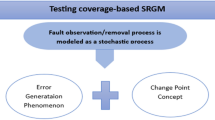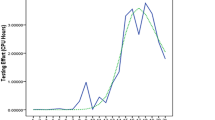Abstract
Due to the complexity of software systems, the testing team may be unable to completely eliminate a problem after observing a failure and the participation of numerous external elements in their development, and another fault may replace the identified fault, also known as error generation. Software developers and customers can benefit from test coverage as a software statistic since it can assist them improve the functionality of tested software and identify what additional effort is necessary to increase the reliability of the software. Software reliability growth models (SRGMs) have been cited as one of the effective methods for quantitative evaluation of software quality. The concept of effort spent and error generation are integrated into a model for testing coverage-based software reliability evaluation. Testing effort spent is supposed to follow the Weibull distribution, whereas testing coverage is described by exponential, delayed S-shaped, and logistic functions respectively. Additionally, we look into the cost requirement-based software release time for exponential functions with a reliability constraint. We introduce the genetic algorithm, which is a powerful tool for dealing with search and optimization issues. Two real failure datasets have been used to test different goodness of fit criteria for the model and their performance is evaluated using four goodness-of-fit metrics, including coefficient of determination \(\left({\mathrm{R}}^{2}\right)\), mean square error (MSE), predictive power (PP) and predictive ratio risk (PRR). The acquired results outperform the perfect debugging model and demonstrate notable advancements that are fairly encouraging.





Similar content being viewed by others
References
Arora, R., Aggarwal, A.: Testing effort based software reliability assessment incorporating FRF and change point. Yugoslav J. Op. Res. 30(3), 273–288 (2020). https://doi.org/10.2298/YJOR190315022A
Brooks, W., Motley, R.: Analysis of Discrete Software Reliability Models. IBM Federal Systems Division, Gaithersburg (1980)
Chatterjee, S., Singh, J.B.: A NHPP based software reliability model and optimal release policy with logistic–exponential test coverage under imperfect debugging. Int. J. Syst. Assur. Eng. Manag. 5(3), 399–406 (2014). https://doi.org/10.1007/s13198-013-0181-6
Chatterjee, S., Shukla, A.: A unified approach of testing coverage-based software reliability growth modelling with fault detection probability, imperfect debugging, and change point. J. Softw. Evolut. Process 31(3), e2150 (2019). https://doi.org/10.1002/smr.2150
Chaudhary, S., Sinha, A., Singh, D., Mishra, S.: A review on software realibility growth modelling. Int. J. Eng. Res. Technol. 8(10), 113–116 (2020)
Huang, C.-Y., Lo, J.-H., Kuo, S.-Y., Lyu, M. R.: Optimal allocation of testing resources for modular software systems. In: 13th International Symposium on Software Reliability Engineering, 2002. Proceedings., 129–138. https://doi.org/10.1109/ISSRE.2002.1173228(2002)
Gupta, R., Jain, M., Jain, A.: (2019) Software Reliability Growth Model in Distributed Environment Subject to Debugging Time Lag (pp. 105–118). https://doi.org/10.1007/978-981-13-0857-4_7
Huang, C.-Y.: Performance analysis of software reliability growth models with testing-effort and change-point. J. Syst. Softw. 76(2), 181–194 (2005). https://doi.org/10.1016/j.jss.2004.04.024
Huang, Y.S., Chiu, K.C., Chen, W.M.: A software reliability growth model for imperfect debugging. J. Syst. Softw. 188, 111267 (2022). https://doi.org/10.1016/j.jss.2022.111267
Inoue, S., Yamada, S.: Two-dimensional software reliability assessment with testing-coverage. Second Int. Conf. Secur. Syst. Integr. Reliab. Improvem. 2008, 150–157 (2008). https://doi.org/10.1109/SSIRI.2008.21
Jain, M., Jain, A., Gupta, R.: Analysis of Module-Based Software Reliability Growth Model Incorporating Imperfect Debugging and Fault Reduction Factor (pp. 69–80). https://doi.org/10.1007/978-981-10-5577-5_6 (2018)
Kapur, P.K., Garg, R.B.: Optimum release policy for an inflection s-shaped software reliability growth model. Microelectron. Reliab. 31(1), 39–41 (1991). https://doi.org/10.1016/0026-2714(91)90343-6
Kapur, P.K., Garg, R.B., Aggarwal, A.G., Tandon, A.: General framework for change point problem in software reliability and related release time problem. Int. J. Reliab. Qual. Saf. Eng. 16(06), 567–579 (2009). https://doi.org/10.1142/S0218539309003587
Kapur, P.K., Gupta, A., Shatnawi, O., Yadavalli, V.S.S.: Testing effort control using flexible software reliability growth model with change point. Int. J. Perform. Eng. 2(3), 245–263 (2006)
Kapur, P.K., Pham, H., Aggarwal, A.G., Kaur, G.: Two dimensional multi-release software reliability modeling and optimal release planning. IEEE Trans. Reliab. 61(3), 758–768 (2012). https://doi.org/10.1109/TR.2012.2207531
Kapur, P.K., Shatnawi, O., Aggarwal, A.G., Kumar, R.: Unified framework for developing testing effort dependent software reliability growth models. WSEAS Trans. Syst. 8(4), 521–531 (2009)
Khurshid, S., Shrivastava, A.K., Iqbal, J.: Effort based software reliability model with fault reduction factor, change point and imperfect debugging. Int. J. Inf. Technol. 13(1), 331–340 (2021). https://doi.org/10.1007/s41870-019-00286-x
Kumar, V., Kapur, P. K., Sahni, R., Shrivastava, A. K.: Testing Time and Effort-Based Successive Release Modeling of a Software in the Presence of Imperfect Debugging (pp. 421–434). https://doi.org/10.1007/978-981-10-5577-5_33 (2018)
Li, Q., Pham, H.: NHPP software reliability model considering the uncertainty of operating environments with imperfect debugging and testing coverage. Appl. Math. Model. 51, 68–85 (2017). https://doi.org/10.1016/j.apm.2017.06.034
Malaiya, Y.K., Li, M.N., Bieman, J.M., Karcich, R.: Software reliability growth with test coverage. IEEE Trans. Reliab. 51(4), 420–426 (2002). https://doi.org/10.1109/TR.2002.804489
Panwar, S., Kumar, V., Kapur, P.K., Singh, O.: Software reliability prediction and release time management with coverage. Int. J. Quality Reliab. Manag. 39(3), 741–761 (2022). https://doi.org/10.1108/IJQRM-05-2021-0139
Peng, R., Li, Y.F., Zhang, W.J., Hu, Q.P.: Testing effort dependent software reliability model for imperfect debugging process considering both detection and correction. Reliab. Eng. Syst. Saf. 126, 37–43 (2014). https://doi.org/10.1016/j.ress.2014.01.004
Pham, H.: Loglog fault-detection rate and testing coverage software reliability models subject to random environments. Vietnam J. Comput. Sci. 1(1), 39–45 (2014). https://doi.org/10.1007/s40595-013-0003-4
Pham, H., Zhang, X.: NHPP software reliability and cost models with testing coverage. Eur. J. Oper. Res. 145(2), 443–454 (2003). https://doi.org/10.1016/S0377-2217(02)00181-9
Song, K.Y., Chang, I.H., Pham, H.: A testing coverage model based on NHPP software reliability considering the software operating environment and the sensitivity analysis. Mathematics 7(450), 1–21 (2019). https://doi.org/10.3390/math7050450
Tandon, A., Aggarwal, A.G., Nijhawan, N.: An NHPP SRGM with change point and multiple releases. Int. J. Inform. Syst. Service Sector 8(4), 57–68 (2016). https://doi.org/10.4018/IJISSS.2016100105
Neha, T.A., Aggarwal, A.G.: Testing coverage based reliability modeling for multi-release open-source software incorporating fault reduction factor. Life Cycle Reliab. Safety Eng. 9(4), 425–435 (2020). https://doi.org/10.1007/s41872-020-00148-7
Verma, V., Anand, S., Kapur, P.K., Aggarwal, A.G.: Unified framework to assess software reliability and determine optimal release time in presence of fault reduction factor, error generation and fault removal efficiency. Int. J. Syst. Assur. Eng. Manag. (2022). https://doi.org/10.1007/s13198-022-01653-x
Wood, A.: Predicting software reliability. Computer 29(11), 69–77 (1996). https://doi.org/10.1109/2.544240
Yamada, S., Ohtera, H., Narihisa, H.: A testing-effort dependent software reliability model and its application. Microelectron. Reliab. 27(3), 507–522 (1987). https://doi.org/10.1016/0026-2714(87)90469-0
Zhu, M., Pham, H.: Environmental factors analysis and comparison affecting software reliability in development of multi-release software. J. Syst. Softw. 132, 72–84 (2017). https://doi.org/10.1016/J.JSS.2017.05.097
Acknowledgements
The author (Sudeep Kumar) gratefully acknowledges the funding support provided by the Council of Scientific and Industrial Research (CSIR), New Delhi (File no. 09/915(0018)/2019-EMR-I).
Author information
Authors and Affiliations
Corresponding author
Ethics declarations
Conflict of interest
There are no conflicts of interest to declare.
Additional information
Publisher's Note
Springer Nature remains neutral with regard to jurisdictional claims in published maps and institutional affiliations.
Rights and permissions
Springer Nature or its licensor (e.g. a society or other partner) holds exclusive rights to this article under a publishing agreement with the author(s) or other rightsholder(s); author self-archiving of the accepted manuscript version of this article is solely governed by the terms of such publishing agreement and applicable law.
About this article
Cite this article
Kumar, S., Aggarwal, A.G. & Gupta, R. Testing coverage based software reliability assessment incorporating effort expenditure and error generation. OPSEARCH 60, 1888–1901 (2023). https://doi.org/10.1007/s12597-023-00680-x
Accepted:
Published:
Issue Date:
DOI: https://doi.org/10.1007/s12597-023-00680-x




